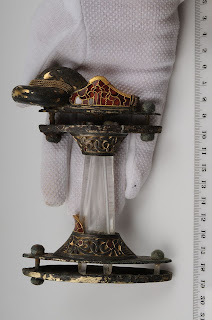The blade is pattern welded using 3 bars of material. The bar along the spine is wrought iron from an old wagon wheel. The center bar is 24 (?) layers of 15N20 and 1095 That is twisted for part of it's length. The untwisted part is inlaid with runes of orichalum (the roman's fancy name for 85% copper and 15% zinc). One one side is the blades name, Bisceopes Eofor, and the other is "MHB besmidede me" which is old english for "MHB smithed me in a forge surrounded by metal" (the owner is an expert in old english and did the translations -any mistakes are mine).
The edge bar is 432 layer of 15N20 and 1095 in a straight laminate with the layers running up and down. Between the hammering and the grinding the result is a wonderful pool & eye pattern.
The handle has ferrules on either end that were cast in bronze. The red inlay is gem quality resin that I used in place of the garnets that the anglo-saxons were so fond of. Putting real garnets in would have more than doubled the cost of the piece due to all the lapidary work. The dark wood of the handle is 5,000 year old bog oak from the midlands in england. These trees got buried in approximately 3300 BC and were preserved by the nature of the bog soil. They also darkened considerably as you can see. The center ring is carved moose antler.
This is the boar I carved and cast for the butt of the handle.
The sheath is 10oz tooling leather with bronze fitting I cast myself. The embossed knotwork design comes from the british isles during the appropriate time period.
If you are interested in the construction/creation process take a look at my work-in-progress post on Bladesmith's Forum.

























